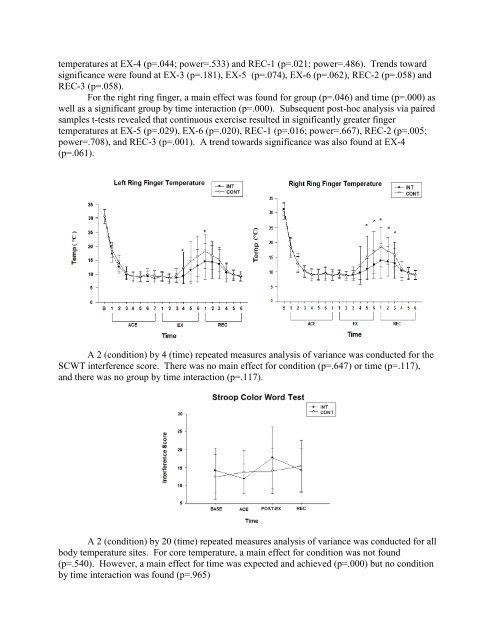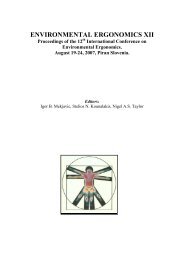Matthew D. Muller.pdf
Matthew D. Muller.pdf
Matthew D. Muller.pdf
Create successful ePaper yourself
Turn your PDF publications into a flip-book with our unique Google optimized e-Paper software.
temperatures at EX-4 (p=.044; power=.533) and REC-1 (p=.021; power=.486). Trends toward<br />
significance were found at EX-3 (p=.181), EX-5 (p=.074), EX-6 (p=.062), REC-2 (p=.058) and<br />
REC-3 (p=.058).<br />
For the right ring finger, a main effect was found for group (p=.046) and time (p=.000) as<br />
well as a significant group by time interaction (p=.000). Subsequent post-hoc analysis via paired<br />
samples t-tests revealed that continuous exercise resulted in significantly greater finger<br />
temperatures at EX-5 (p=.029), EX-6 (p=.020), REC-1 (p=.016; power=.667), REC-2 (p=.005;<br />
power=.708), and REC-3 (p=.001). A trend towards significance was also found at EX-4<br />
(p=.061).<br />
A 2 (condition) by 4 (time) repeated measures analysis of variance was conducted for the<br />
SCWT interference score. There was no main effect for condition (p=.647) or time (p=.117),<br />
and there was no group by time interaction (p=.117).<br />
A 2 (condition) by 20 (time) repeated measures analysis of variance was conducted for all<br />
body temperature sites. For core temperature, a main effect for condition was not found<br />
(p=.540). However, a main effect for time was expected and achieved (p=.000) but no condition<br />
by time interaction was found (p=.965)
















